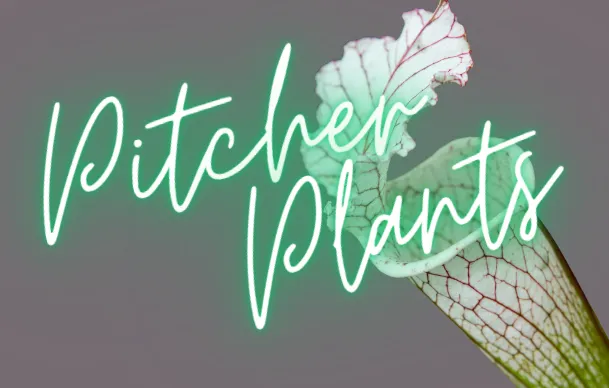
Discover the Fascinating World of Pitcher Plants:
A Guide for Plant Enthusiasts
Introduction
Welcome, plant aficionados, to the captivating universe of pitcher plants! These botanical marvels are not your typical garden dwellers. They're carnivorous, intriguing, and absolutely delightful to care for. Whether you're a seasoned gardener or a curious newbie enchanted by the allure of these green predators, this article will guide you through the scientific wonders, unique characteristics, care tips, diverse varieties, and propagation methods of pitcher plants. Let's dive into the green, sometimes eerie, but always fascinating world of these botanical wonders!
Scientific Spotlight on Pitcher Plants
Pitcher plants belong to several genera, including Nepenthes, Sarracenia, and Cephalotus, each harboring its unique charm. These plants are characterized by their modified leaves known as pitfall traps—a cunning evolution to capture and digest insects and other small creatures. The scientific intrigue doesn't stop there; pitcher plants have evolved complex relationships with their environment, often offering safe havens to certain arthropod species, which in turn, help lure prey or clean the pitcher.
What makes them stand out in the plant kingdom is their remarkable adaptation to nutrient-poor soils. Instead of relying solely on the ground for sustenance, they've turned to carnivory, making them a fascinating subject for scientists and gardeners alike.
Global Gardens: Where Pitcher Plants Grow Wild
Pitcher plants boast a wide geographical distribution, thriving in diverse habitats across the globe. Each genus has carved out its niche in specific regions, showcasing the adaptability of these carnivorous plants:
Nepenthes: Often called tropical pitcher plants or monkey cups, Nepenthes species are primarily found in the rainforests of Southeast Asia, including Borneo, Sumatra, the Philippines, and Madagascar. Their habitat ranges from lowland jungles to high mountain ridges, with each species adapted to specific environmental conditions.
Sarracenia: Native to North America, particularly the southeastern United States, these pitcher plants flourish in the bogs, pocosins, and pine barrens from Texas to the Great Lakes. Each species adapts to its unique microhabitat, with variations in soil, moisture, and sunlight.
Cephalotus follicularis: This rare gem, known as the Australian pitcher plant, is found in a small region of Southwest Australia. It thrives in sandy, nutrient-poor soils, often in coastal plains or forest margins.
Darlingtonia californica: The cobra lily, with its distinctive hooded shape, is native to Northern California and Oregon, preferring cold running water and partial shade.
Heliamphora: The sun pitchers are native to South America, particularly the tepuis of Venezuela, Guyana, and northern Brazil. These plants have adapted to life on nutrient-poor, sandstone plateaus.
This global distribution underlines the incredible adaptability of pitcher plants, each species evolving to exploit the specific conditions of its environment. From the humid, tropical rainforests of Southeast Asia to the temperate bogs of North America, pitcher plants have developed unique strategies to thrive in some of the world's most challenging habitats. Their presence around the globe is a testament to the evolutionary success of the carnivorous plant strategy, making them a fascinating study for scientists and enthusiasts alike.
Unique Charm of Pitcher Plants
Pitcher plants are like the Venus flytraps of the potting world but with a twist. Their pitchers are actually modified leaves designed to lure, trap, and digest unwary insects. These plants are not just about their carnivorous nature; they're also stunningly beautiful. The pitchers can be vibrant and colorful, with hues ranging from deep greens and purples to bright reds and yellows, often speckled or veined in contrasting colors to attract their prey—and our admiration.
Caring for Your Carnivorous Companions
Light: These plants thrive in bright, indirect sunlight. A spot that mimics the dappled light of their natural habitat is ideal.
Water: Pure water is key—rainwater, distilled water, or reverse osmosis water only. Their roots are sensitive to the minerals found in tap water.
Soil: Use a mix specifically designed for carnivorous plants, usually a blend of sphagnum peat moss and perlite. This ensures proper drainage and mimics their natural, nutrient-poor substrate.
Humidity: High humidity is a plus, especially for tropical varieties. A humidity tray or a place in a humid room can help meet this requirement.
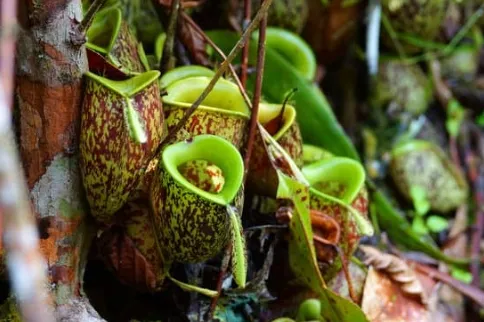
Nepenthes sp. (pitcher-shaped, in tropical places like Borneo Rainforests)
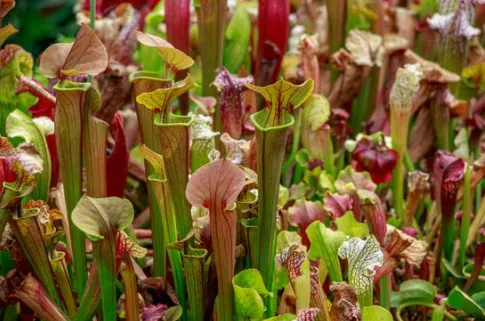
Sarracenia sp. (seen in North American)
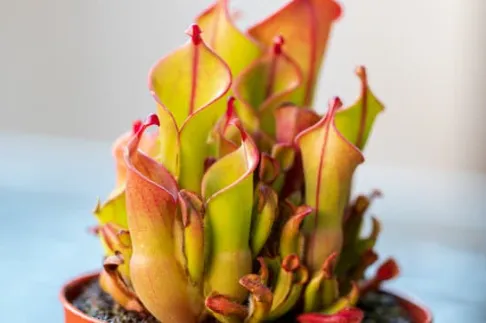
Heliamphora sp. (seen in South American)
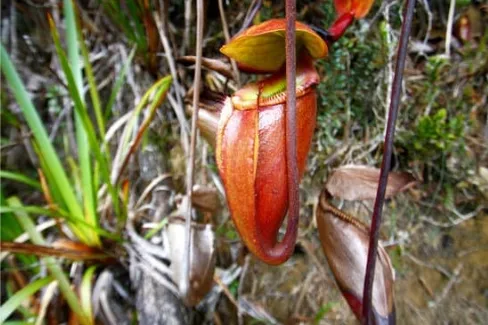
Cephalotus sp. (most notably tied to Australia)
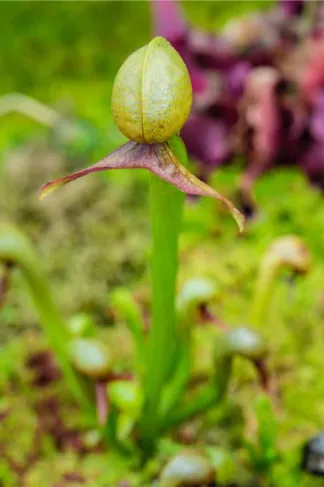
Darlingtonia californica (California & Oregon - Cobra Lily)
A Kaleidoscope of Varieties and Colors
From the towering Nepenthes rajah to the diminutive Cephalotus follicularis, pitcher plants come in a wide range of sizes, shapes, and colors. The Sarracenia species, native to North America, offers a variety of shapes from the slender, towering pitchers of Sarracenia leucophylla to the squat, bulbous jugs of Sarracenia purpurea. Each species and hybrid boasts its own unique pattern, making them a dazzling addition to any collection.
Propagation: More Pitchers, Please!
Propagating pitcher plants can be as fun as it is rewarding. Here are a few methods:
Division: Mature plants can often be divided during repotting. This is the simplest way to get more plants, especially with Sarracenia and Cephalotus.
Cuttings: Leaf cuttings can be a successful method for some species, particularly Nepenthes. Cut a leaf with a bit of tendril, plant it in moist sphagnum moss, and wait for the magic to happen.
Seeds: Growing pitcher plants from seeds can be a slow but satisfying process. Be patient, as germination can take several weeks or even months, and it may be years before your plantlets resemble the captivating adults.
Final Thoughts
Pitcher plants are more than just a green curiosity; they're a window into the incredible adaptability and diversity of the plant kingdom. They remind us that plants are not passive beings but active, sometimes cunning participants in their ecosystems. Whether you're drawn to their carnivorous nature, their striking appearance, or the challenge of caring for them, pitcher plants offer something for every plant lover. So, why not add a pitcher plant (or two) to your botanical collection and enjoy the thrill of growing these fascinating creatures? Happy gardening!
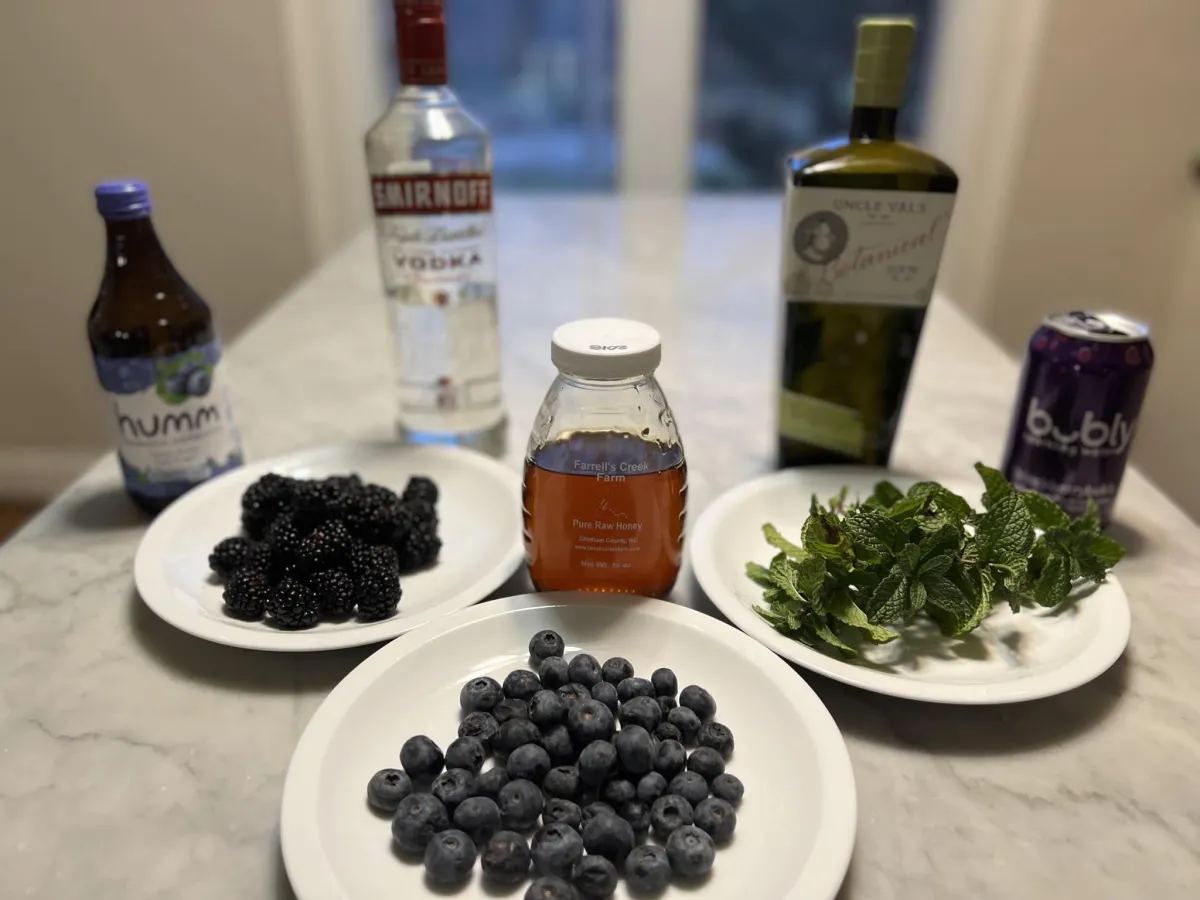


Receive free recipes, education, and exclusive email offers for our products, those of our friends and affiliates and notifications of new content.

email: [email protected]
Disclaimer: * Should you make a purchase via a link found in this website, it's important to understand that we may have a partnership with the provider of the product or service you're buying, which could result in compensation for us. We encourage you to conduct your own research prior to making any purchases.
Copyright 2023. All rights reserved.
